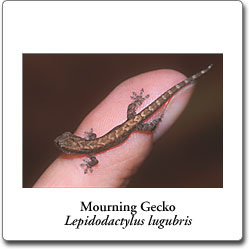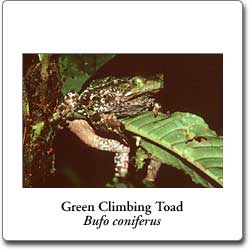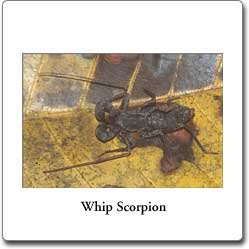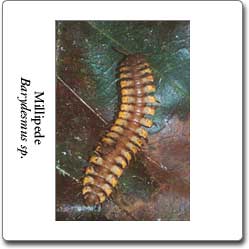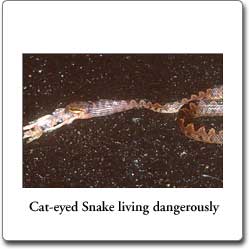
 |
page 2 of 5 |
 |
|
|
|
Click any image to see a larger version.
|
|
|
Creatures of the Night
Most of the species
we found were discovered at night, for a couple of reasons. Some species, like most of the
frogs and snakes, are primarily active at night. Other species are so well camouflaged that
they are easier to notice when you're concentrating on the spot of a flashlight than when
you're just looking around at everything. When we found new or interesting species on our
nightly escapades, we'd usually capture them and keep them in plastic bags for later daytime
photography, though some were photographed in place.
|
|
|
|
We all had a common interest in herps, but people's attitudes towards the other forest
creatures were more varied. Bill was very excited that we discovered a pair of whip
scorpions -- the first he had ever seen in this area -- but for some reason Maria and Vicki
weren't particularly interested in letting one crawl across their hands. Maria found a
lovely spinal-column-shaped millipede, but preferred to let me pick it up. We all loved the
little bats that roosted in the eaves of our cabins, but we were generally more at ease
when they weren't flying an inch or two away from our faces.
|
|
|
|
Road cruising at night is the easiest way to find snakes in many
parts of the world, including those areas of the neotropics that feature roads.
We were hoping to find lots and lots of snakes, both on the roads and in
the forest. On a similar trip
the previous year Bill's group had counted 46 snakes in about a week, an amazingly
high number. We were not so fortunate. On our first night we came up with
only one snake while hiking. The next morning Bill, Alejandro, and I
hiked by ourselves, and we saw no snakes at all. This was enough
to convince Bill that I was a snake jinx, a hypothesis he reiterated often
on the next several snake-poor days of herp hunting.
Late in the week, we took a nighttime drive from Esquinas north on the Pan-American
Highway to the new coastal road between Palmar Norte and Dominical. This was a road
on which Alejandro had recently seen snakes galore. It was a dark and stormy night, which
may sound ominous in mystery novels but is promising for herp hunting. Bill said
"This is a perfect night to find a caecilian." Caecilians are legless amphibians
that resemble giant earthworms -- I had never seen a caecilian in the
wild or even in a zoo, so Bill's words were what I wanted to hear. But since I was a
snake jinx, maybe I'd be a caecilian jinx too?
About ten minutes after Bill's pronouncement, he or Alejandro spotted
a snake on the road. Alejandro stopped the van and Bill leapt out and ran
over to bag the snake. Only it wasn't a snake at all -- it was the predicted
caecilian! Woo hoo!
|
|
|
|
The caecilian apparently broke my snake jinx too, at least for that evening. We saw a decent
number of snakes thereafter. Unfortunately many of them were dead on the road, a
far-too-common sight when road cruising for herps. (You rarely see dead snakes on the
road during the day, because they don't last long before some scavenging birds or mammals
clean them up.)
We would stop even for dead snakes so Bill could identify them. Much can be and has been
learned about snakes from road-killed individuals. As I mentioned earlier, Alejandro kept
one of the dead snakes we came across so he could measure it later, since it appeared to be
a particularly long specimen. Indeed, after the measurement he believed it was possibly
a new record size for the Cloudy Snail-eating Snake, Sibon nebulata.
We were glad that we stopped for the dead snakes when one of them turned out to be not
so dead after all. An immobile but perfectly healthy cat-eyed snake, Leptodeira septentrionalis, was
slowly devouring the fairly unpleasant remains of a squashed frog. The snake was quite
fat throughout its length, indicating that this might not have been the first frogsicle
it had dined on this evening. We saved it from likely doom by removing it from the scene.
|
|
|
|
|
Next: The Forest By Day
|
